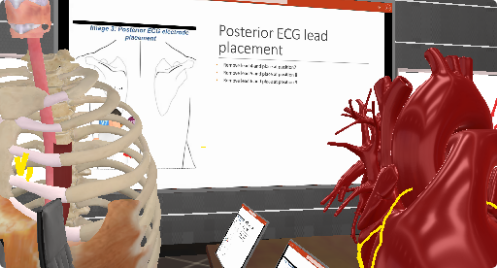At this point it is easy to forsee that a hospital will have a nurse who specializes in VR. Their job will be to help facilitate the maintenance, storage and implementation of hospital wide VR therapies. They will be knowledgeable in clinical issues but also have the fortitude to work with spatial computing. They will be active reseachers and they will work closely with a variety of members within the multi-disciplinary team. Just like every nurses does every day. We are good like that 😉
This weeks blog is brief breakdown of a few entry points for VR in health.
There is no doubt that virtual reality applications in the healthcare industry have significantly progressed. Medical education has already begun to make extensive use of VR and the beneficial impact of VR applications in medical education and training, is now well researched and substantiated. However, VR has also impacted many other sectors in healthcare and there is a wide range of applications for supporting patients, with various diseases or disorders.
VR Simulations for Dementia
With a rapidly aging population, the use of VR simulations has been shown to support practitioners when interacting with patients with dementia. When wearing a VR headset the user can experience the limitations of dementia. By showing the user exactly what a dementia patient may experience when trying to communicate or navigate a space, naturally enhances the empathy that will then be felt by the user towards dementia patients. Additionally by understanding the challenges of diseases, such as, Alzheimer’s and Parkinson’s on a personal level, practitioners are able to modify their communications to better support their patients.
Learning with VR for Autism Spectrum Disorder (ASD)
The Center for BrainHealth and Yale School of Medicine have been studying VR simulations to support learning. VR simulations are designed to enable individuals with ASD to practice and develop new skills ‘Unlike other therapeutic options, such as role-playing, VR represents real-life experiences in a safe, controllable manner that allow for repeated practice and exposure, which is a key element in treatment’.
VR has also been utilized by Floreo, a platform created by Ravindran and Sazawal who have an autistic child. The games are based around communication skills and everyday events that can be challenging for children with autism to understand and learn to navigate, such as crossing a busy road
Mental Health Treatment
Treatment of phobias and post-traumatic stress disorders (PTSD) is being explored with the use of VR simulations which allow patients to explore their fears and triggers, at a pace they are comfortable with. A mobile app called Bravemind, created by the University of Southern California Institute for Creative Technologies, gives users control over a virtual environment where they encounter phobias or situations that will trigger PTSD. During the immersion in VR, brain activities are monitored and the simulations and treatments can be adjusted accordingly, to tailor treatment for each patient based on their responses.
Rehabilitation and Physical Therapy
Rehabilitation after a brain injury can often be slow and challenging for patients. Practicing tasks in a virtual reality setting provides additional stimulation which helps to create higher levels of engagement. Not only can VR make physical therapy more enjoyable, by creating games in a VR environment patients are often more motivated. Additionally VR programs can track development and be tailored to support individual needs, resulting in a quicker and smoother recovery.
Summary
VR is just beginning to be utilized by other sectors of healthcare to provide support to patients and offers a way to transform how patients access treatments. Delivery of care is no longer confined to the limitations of a physical location and VR will inevitably change the infrastructure of health care dramatically, and faster than any other emerging technology in healthcare.
Time to take a snapshot of VR outside of education and training and chat about how patients can be impacted. It is a fact that VR is not a magic bullet. It is not all roses, it is not the answer to our problems in Healthcare. The reality is, in the last few years trials have been done and they have shown that VR provides a benefit. That is not marketing, it is not hype it is god damn hard work to pump out research projects. The most important discussion point, is that research can be found on the TV. “Cancer can be cured with a glass of wine every night” That does not make it credible. The research needs to be analysed and critically discussed within industry to ensure staff and patients are conducting themselves and workplace innovation in a safe and effective manner. Just a few thoughts to ponder.
